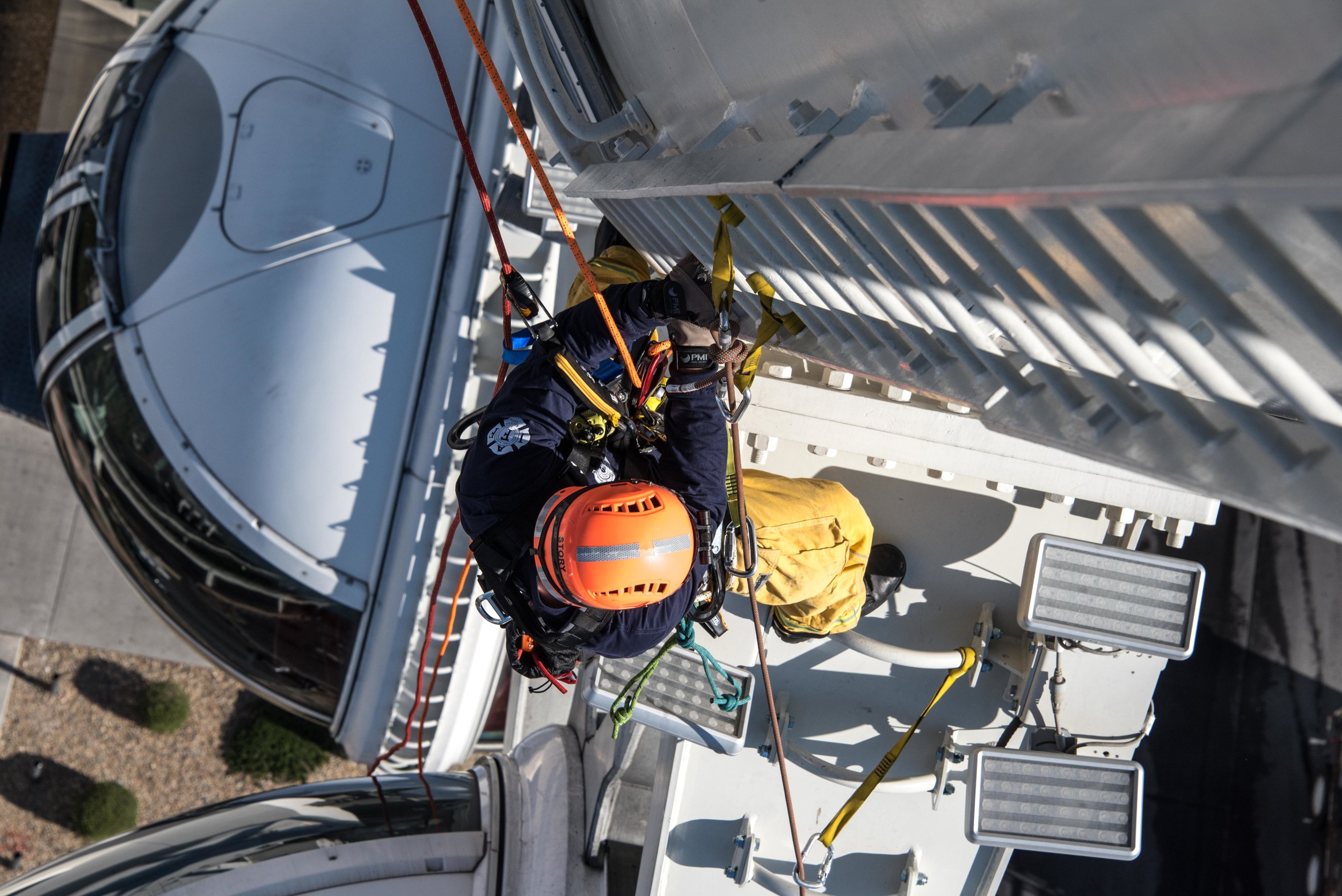
Las Vegas Fire and Rescue responds with the “Heavy Rescue” for technical related calls. Some examples are swift water, complicated vehicle extrication, confined space, structure collapse, trench, and high angle rescue. Here’s a unique example of high angle rescue training on the High Roller Observation Wheel in Las Vegas at The Linq Hotel and Casino. These photographs are from a rescuer’s perspective!

I am part of the Team and use the opportunity to document the training. These photographs illustrate the story of a simulated rescue. The training begins with accessing the center hub to trolly out onto a spoke, rappelling down from the trolly, and making the transition from the rappel lines onto the pod. The training ends with Rescuers entering the pod and setting up a main and belay, finally packaging the patient to be lowered safely to the ground.

At the morning briefing the incident action plan is discussed.

Assignments are made and questions answered.

Rescuers gain access to the “hub” by climbing up one of the legs of the High Roller.

The stairwell narrows as the rescuers climb.

The “hub”.

The assigned rigging personnel use various equipment to secure and lower rescuers out onto a spoke of the wheel.

Once secured the rescuer is safety checked.

The rescuer hangs from a trolley on rappel lines and is lowered out onto a spoke.

From this point the rescuer rappels down the ropes to a pod below.

Hanging in space.

Rappeling.

Two ropes are used while rappelling.

A rescuer loving his job!!

Making the transition from rappel to rescue hooks.

Transition. Once the rappel lines are released, the hub can pull in the trolly to repeat the process and continue adding rescuers to assist with operations in the pod.

Safety first.

Rescue hooks keep rescuer secure to the exterior of the pod.

Rescuers gain access to the interior of the pod.

Rescuers package victim into a special harness to be safely lowered.

Safety check.

Victim has made the edge transition.

Two ropes are used to lower the victim, one main and one belay.

Communication is key during the operation.

The victim is then lowered to the ground. This is the objective of the training. It should be noted that the High Roller has many redundancies to prevent malfunctions and a rescue has never been necessary. This training is important because low frequency equals high risk. Training and preplanning mitigates that risk.

Here’s a selfie with my DSLR… That’s the look of a healthy respect for heights and some hard work!!



























Las Vegas Fire and Rescue responds with the “Heavy Rescue” for technical related calls. Some examples are swift water, complicated vehicle extrication, confined space, structure collapse, trench, and high angle rescue. Here’s a unique example of high angle rescue training on the High Roller Observation Wheel in Las Vegas at The Linq Hotel and Casino. These photographs are from a rescuer’s perspective!
I am part of the Team and use the opportunity to document the training. These photographs illustrate the story of a simulated rescue. The training begins with accessing the center hub to trolly out onto a spoke, rappelling down from the trolly, and making the transition from the rappel lines onto the pod. The training ends with Rescuers entering the pod and setting up a main and belay, finally packaging the patient to be lowered safely to the ground.
At the morning briefing the incident action plan is discussed.
Assignments are made and questions answered.
Rescuers gain access to the “hub” by climbing up one of the legs of the High Roller.
The stairwell narrows as the rescuers climb.
The “hub”.
The assigned rigging personnel use various equipment to secure and lower rescuers out onto a spoke of the wheel.
Once secured the rescuer is safety checked.
The rescuer hangs from a trolley on rappel lines and is lowered out onto a spoke.
From this point the rescuer rappels down the ropes to a pod below.
Hanging in space.
Rappeling.
Two ropes are used while rappelling.
A rescuer loving his job!!
Making the transition from rappel to rescue hooks.
Transition. Once the rappel lines are released, the hub can pull in the trolly to repeat the process and continue adding rescuers to assist with operations in the pod.
Safety first.
Rescue hooks keep rescuer secure to the exterior of the pod.
Rescuers gain access to the interior of the pod.
Rescuers package victim into a special harness to be safely lowered.
Safety check.
Victim has made the edge transition.
Two ropes are used to lower the victim, one main and one belay.
Communication is key during the operation.
The victim is then lowered to the ground. This is the objective of the training. It should be noted that the High Roller has many redundancies to prevent malfunctions and a rescue has never been necessary. This training is important because low frequency equals high risk. Training and preplanning mitigates that risk.
Here’s a selfie with my DSLR… That’s the look of a healthy respect for heights and some hard work!!
